Designing and Developing an Effective Training
VerifiedAdded on 2021/01/01
|11
|2009
|208
AI Summary
Contribute Materials
Your contribution can guide someone’s learning journey. Share your
documents today.
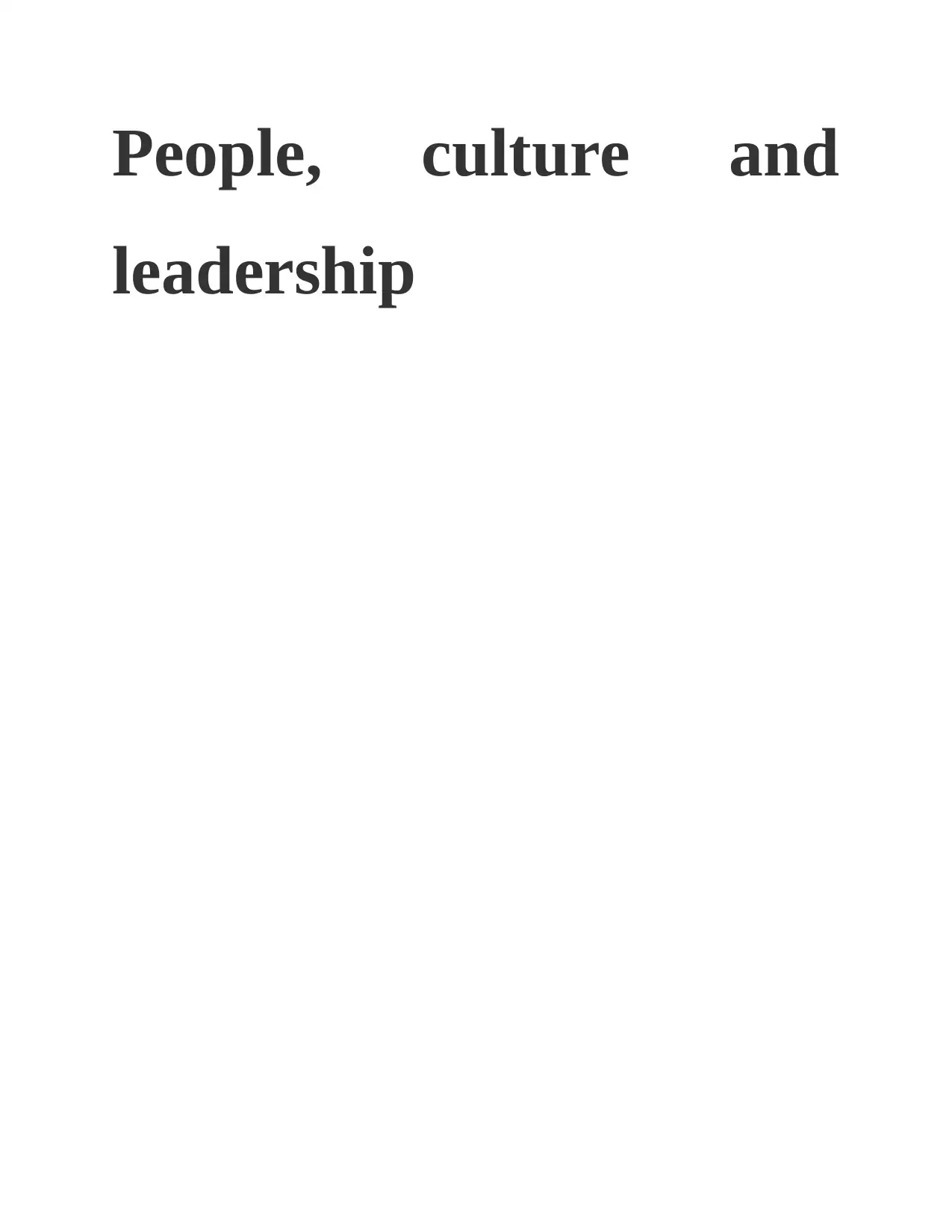
People, culture and
leadership
leadership
Secure Best Marks with AI Grader
Need help grading? Try our AI Grader for instant feedback on your assignments.
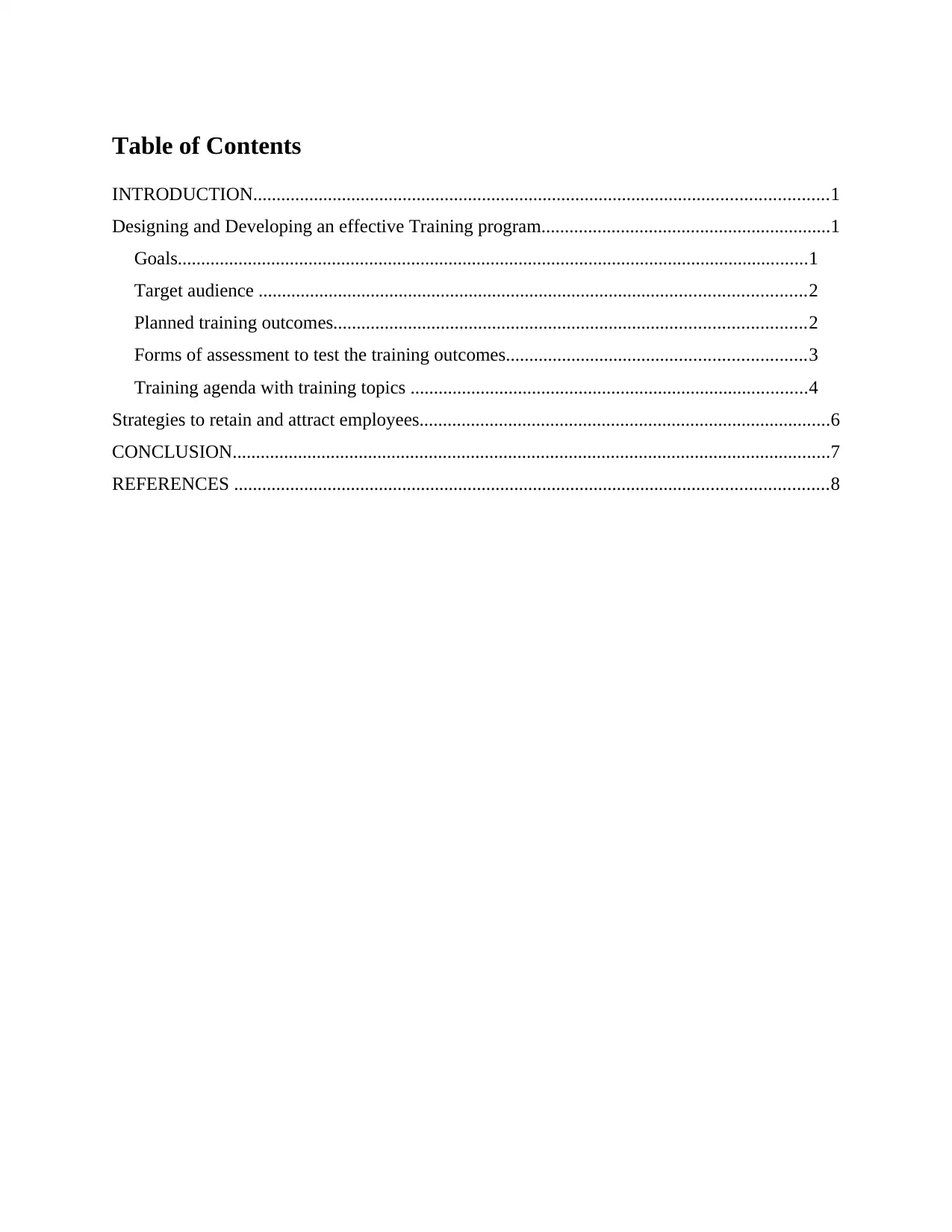
Table of Contents
INTRODUCTION...........................................................................................................................1
Designing and Developing an effective Training program..............................................................1
Goals.......................................................................................................................................1
Target audience .....................................................................................................................2
Planned training outcomes.....................................................................................................2
Forms of assessment to test the training outcomes................................................................3
Training agenda with training topics .....................................................................................4
Strategies to retain and attract employees........................................................................................6
CONCLUSION................................................................................................................................7
REFERENCES ...............................................................................................................................8
INTRODUCTION...........................................................................................................................1
Designing and Developing an effective Training program..............................................................1
Goals.......................................................................................................................................1
Target audience .....................................................................................................................2
Planned training outcomes.....................................................................................................2
Forms of assessment to test the training outcomes................................................................3
Training agenda with training topics .....................................................................................4
Strategies to retain and attract employees........................................................................................6
CONCLUSION................................................................................................................................7
REFERENCES ...............................................................................................................................8
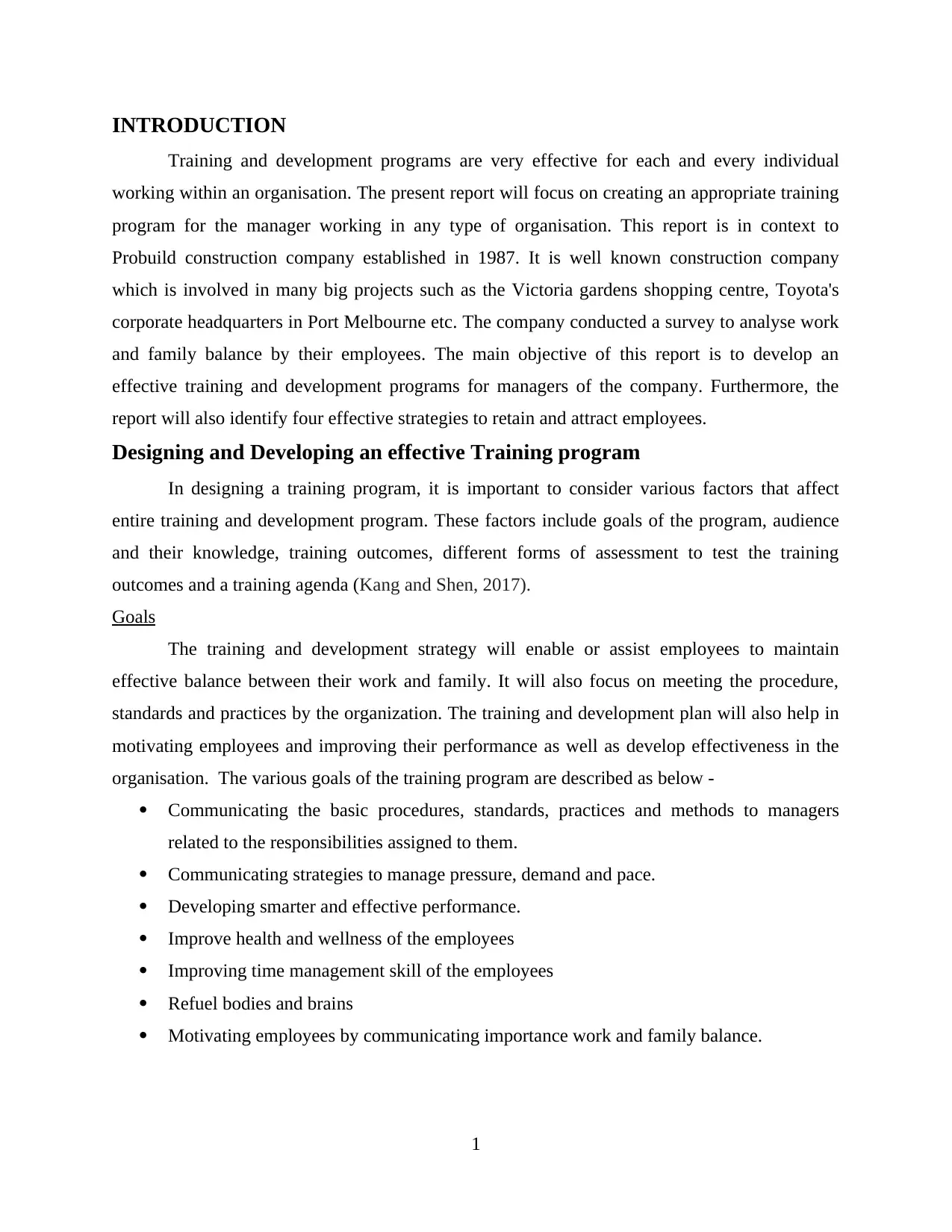
INTRODUCTION
Training and development programs are very effective for each and every individual
working within an organisation. The present report will focus on creating an appropriate training
program for the manager working in any type of organisation. This report is in context to
Probuild construction company established in 1987. It is well known construction company
which is involved in many big projects such as the Victoria gardens shopping centre, Toyota's
corporate headquarters in Port Melbourne etc. The company conducted a survey to analyse work
and family balance by their employees. The main objective of this report is to develop an
effective training and development programs for managers of the company. Furthermore, the
report will also identify four effective strategies to retain and attract employees.
Designing and Developing an effective Training program
In designing a training program, it is important to consider various factors that affect
entire training and development program. These factors include goals of the program, audience
and their knowledge, training outcomes, different forms of assessment to test the training
outcomes and a training agenda (Kang and Shen, 2017).
Goals
The training and development strategy will enable or assist employees to maintain
effective balance between their work and family. It will also focus on meeting the procedure,
standards and practices by the organization. The training and development plan will also help in
motivating employees and improving their performance as well as develop effectiveness in the
organisation. The various goals of the training program are described as below -
Communicating the basic procedures, standards, practices and methods to managers
related to the responsibilities assigned to them.
Communicating strategies to manage pressure, demand and pace.
Developing smarter and effective performance.
Improve health and wellness of the employees
Improving time management skill of the employees
Refuel bodies and brains
Motivating employees by communicating importance work and family balance.
1
Training and development programs are very effective for each and every individual
working within an organisation. The present report will focus on creating an appropriate training
program for the manager working in any type of organisation. This report is in context to
Probuild construction company established in 1987. It is well known construction company
which is involved in many big projects such as the Victoria gardens shopping centre, Toyota's
corporate headquarters in Port Melbourne etc. The company conducted a survey to analyse work
and family balance by their employees. The main objective of this report is to develop an
effective training and development programs for managers of the company. Furthermore, the
report will also identify four effective strategies to retain and attract employees.
Designing and Developing an effective Training program
In designing a training program, it is important to consider various factors that affect
entire training and development program. These factors include goals of the program, audience
and their knowledge, training outcomes, different forms of assessment to test the training
outcomes and a training agenda (Kang and Shen, 2017).
Goals
The training and development strategy will enable or assist employees to maintain
effective balance between their work and family. It will also focus on meeting the procedure,
standards and practices by the organization. The training and development plan will also help in
motivating employees and improving their performance as well as develop effectiveness in the
organisation. The various goals of the training program are described as below -
Communicating the basic procedures, standards, practices and methods to managers
related to the responsibilities assigned to them.
Communicating strategies to manage pressure, demand and pace.
Developing smarter and effective performance.
Improve health and wellness of the employees
Improving time management skill of the employees
Refuel bodies and brains
Motivating employees by communicating importance work and family balance.
1

Target audience
In order to develop and implement an effective training or any other strategies on
employees it is important to know them properly. The employees have different behaviours,
skills, ability and understanding which is important to analyse in order to provide the most
effective training (Locke, 2017). Various training programs are provided to audience including
various demographics with regards to job role, education, expertise, time management etc. Every
training participant has different preferences in terms of learning and motivations. For example –
new hiring training is offered to new employees in each and every roles within the Pro build
construction company from production to executives. To analyse the target audience various
methods can be utilised as described below -
Attitude – What does it take to get buy in from this group, What drives their performance,
Are there enablers or barriers to training?. Are they open or motivated to learning new
material? Are they a high performance group?
Language and culture – What is written language of the group and primary spoken? Are
there specific considerations to be considered? Are they part of a union or organisation?
Do they tend to be competitive or collaborative ?
Environment – It includes the identification of types of employees such as hourly,
temporary or permanent employees. Kind of workspace such as construction building,
safety standards that important during training.
Subject matter expertise -It includes analysing level of knowledge the employees have
and experience in their role or duties.
Planned training outcomes
The training outcomes are very essential to be planned according to the needs to
individuals, in order to get the bets results of a training and development program. Therefore,
there are planned objectives or outcomes for every training programs conducted for the
employees. For the development and training program in the Probuild construction there are
certain outcomes that are planned by the managers which are as mentioned below -
Increase in employee motivation
Increase in employee performance
Increase in organisation's performance
2
In order to develop and implement an effective training or any other strategies on
employees it is important to know them properly. The employees have different behaviours,
skills, ability and understanding which is important to analyse in order to provide the most
effective training (Locke, 2017). Various training programs are provided to audience including
various demographics with regards to job role, education, expertise, time management etc. Every
training participant has different preferences in terms of learning and motivations. For example –
new hiring training is offered to new employees in each and every roles within the Pro build
construction company from production to executives. To analyse the target audience various
methods can be utilised as described below -
Attitude – What does it take to get buy in from this group, What drives their performance,
Are there enablers or barriers to training?. Are they open or motivated to learning new
material? Are they a high performance group?
Language and culture – What is written language of the group and primary spoken? Are
there specific considerations to be considered? Are they part of a union or organisation?
Do they tend to be competitive or collaborative ?
Environment – It includes the identification of types of employees such as hourly,
temporary or permanent employees. Kind of workspace such as construction building,
safety standards that important during training.
Subject matter expertise -It includes analysing level of knowledge the employees have
and experience in their role or duties.
Planned training outcomes
The training outcomes are very essential to be planned according to the needs to
individuals, in order to get the bets results of a training and development program. Therefore,
there are planned objectives or outcomes for every training programs conducted for the
employees. For the development and training program in the Probuild construction there are
certain outcomes that are planned by the managers which are as mentioned below -
Increase in employee motivation
Increase in employee performance
Increase in organisation's performance
2
Paraphrase This Document
Need a fresh take? Get an instant paraphrase of this document with our AI Paraphraser

Enhancement in employee retention
Reduction in stress, pressure and workload among employees
Improvement in working environment
Development of healthy and happy lifestyle within employees
Easy achievement of individual and organisational goals
Forms of assessment to test the training outcomes
The training programs or outcomes needs to be evaluated for testing whether the program
was effective or not. The delivered training needs to be measured in order to evaluate its
effectiveness. There are various tools such as Kirkpatricks Four level training evaluation model,
it is a significant method that helps in analysing impact and effectiveness of the training program
so that it can be improved in the future. The Four level training evaluation is described as below
-
Level 1: Reaction – These is the first level of training evaluation, it helps in measuring
how the employees who are trained reacted to the training and development program. Its
essential to measure or evaluate to understand how well the training was achieved by
audience such as audience. It plays an important role in improving the future training
program (Kennedy, Dunsmuir and Cameron, 2017)
Level 2 : Learning – This level measure what the employees have learned or how much
their knowledge have increased as a result of training program. There are various
objectives planned for every training session, it is important to measure the learning with
respect to these objectives. The learning can be measured in various ways depending
upon the outcomes or changes to skills, knowledge or attitude.
Level 3 : Behaviour – The change in behaviour of employees shows that training was
effective and employees have learned something whereas if there is non change in their
behaviour it can be concluded that the training and development plan was ineffective.
Level 4 : Results – This is the last level of evaluation, it includes results that were
determined by the organisation to be beneficial for the business, employees and other
stakeholders (Rowland, Hall and Altarawneh, 2017).
3
Reduction in stress, pressure and workload among employees
Improvement in working environment
Development of healthy and happy lifestyle within employees
Easy achievement of individual and organisational goals
Forms of assessment to test the training outcomes
The training programs or outcomes needs to be evaluated for testing whether the program
was effective or not. The delivered training needs to be measured in order to evaluate its
effectiveness. There are various tools such as Kirkpatricks Four level training evaluation model,
it is a significant method that helps in analysing impact and effectiveness of the training program
so that it can be improved in the future. The Four level training evaluation is described as below
-
Level 1: Reaction – These is the first level of training evaluation, it helps in measuring
how the employees who are trained reacted to the training and development program. Its
essential to measure or evaluate to understand how well the training was achieved by
audience such as audience. It plays an important role in improving the future training
program (Kennedy, Dunsmuir and Cameron, 2017)
Level 2 : Learning – This level measure what the employees have learned or how much
their knowledge have increased as a result of training program. There are various
objectives planned for every training session, it is important to measure the learning with
respect to these objectives. The learning can be measured in various ways depending
upon the outcomes or changes to skills, knowledge or attitude.
Level 3 : Behaviour – The change in behaviour of employees shows that training was
effective and employees have learned something whereas if there is non change in their
behaviour it can be concluded that the training and development plan was ineffective.
Level 4 : Results – This is the last level of evaluation, it includes results that were
determined by the organisation to be beneficial for the business, employees and other
stakeholders (Rowland, Hall and Altarawneh, 2017).
3
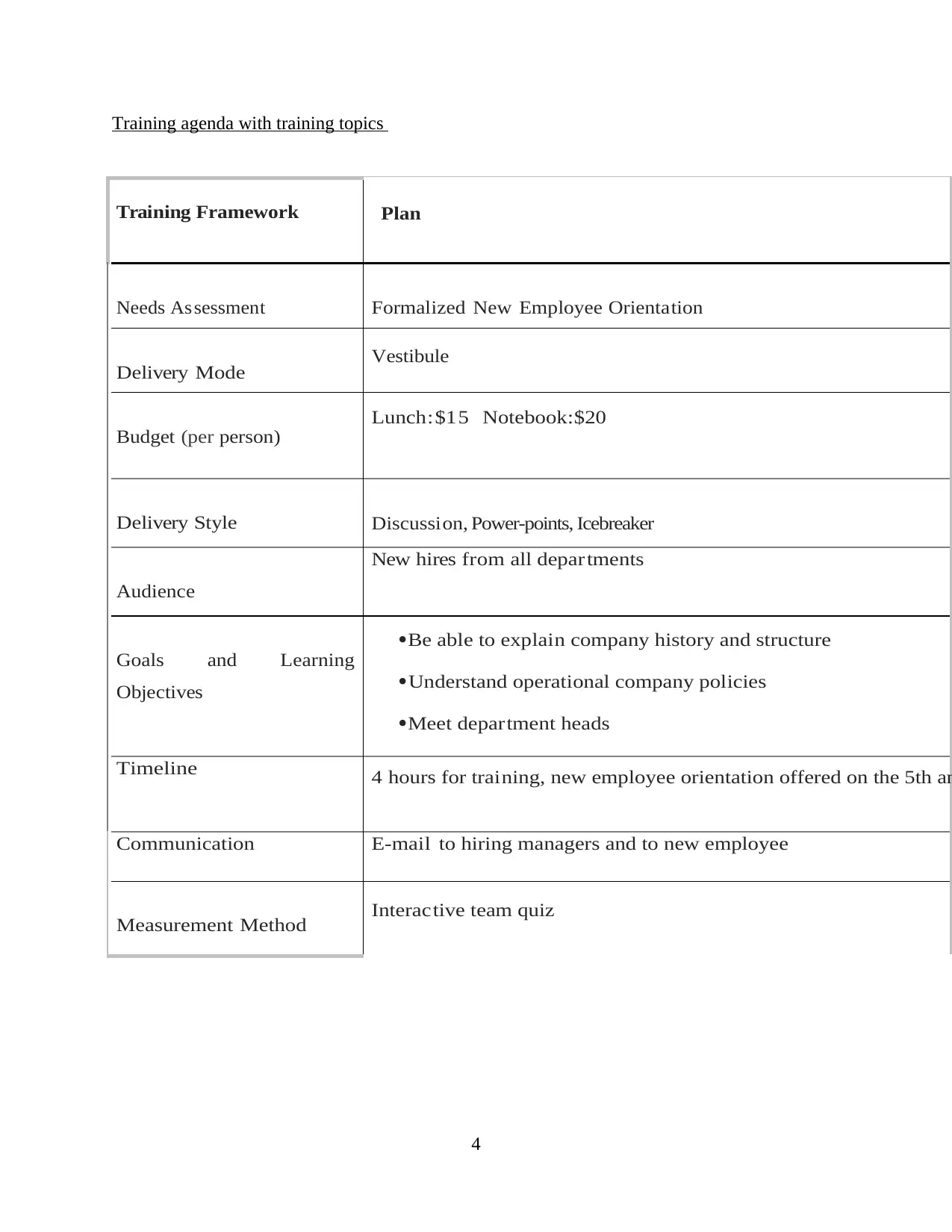
Training agenda with training topics
Training Framework Plan
Needs Assessment Formalized New Employee Orientation
Delivery Mode Vestibule
Budget (per person)
Lunch:$15 Notebook:$20
Delivery Style Discussion, Power-points, Icebreaker
Audience
New hires from all departments
Goals and Learning
Objectives
Be able to explain company history and structure
Understand operational company policies
Meet department heads
Timeline 4 hours for training, new employee orientation offered on the 5th an
Communication E-mail to hiring managers and to new employee
Measurement Method Interactive team quiz
4
Training Framework Plan
Needs Assessment Formalized New Employee Orientation
Delivery Mode Vestibule
Budget (per person)
Lunch:$15 Notebook:$20
Delivery Style Discussion, Power-points, Icebreaker
Audience
New hires from all departments
Goals and Learning
Objectives
Be able to explain company history and structure
Understand operational company policies
Meet department heads
Timeline 4 hours for training, new employee orientation offered on the 5th an
Communication E-mail to hiring managers and to new employee
Measurement Method Interactive team quiz
4
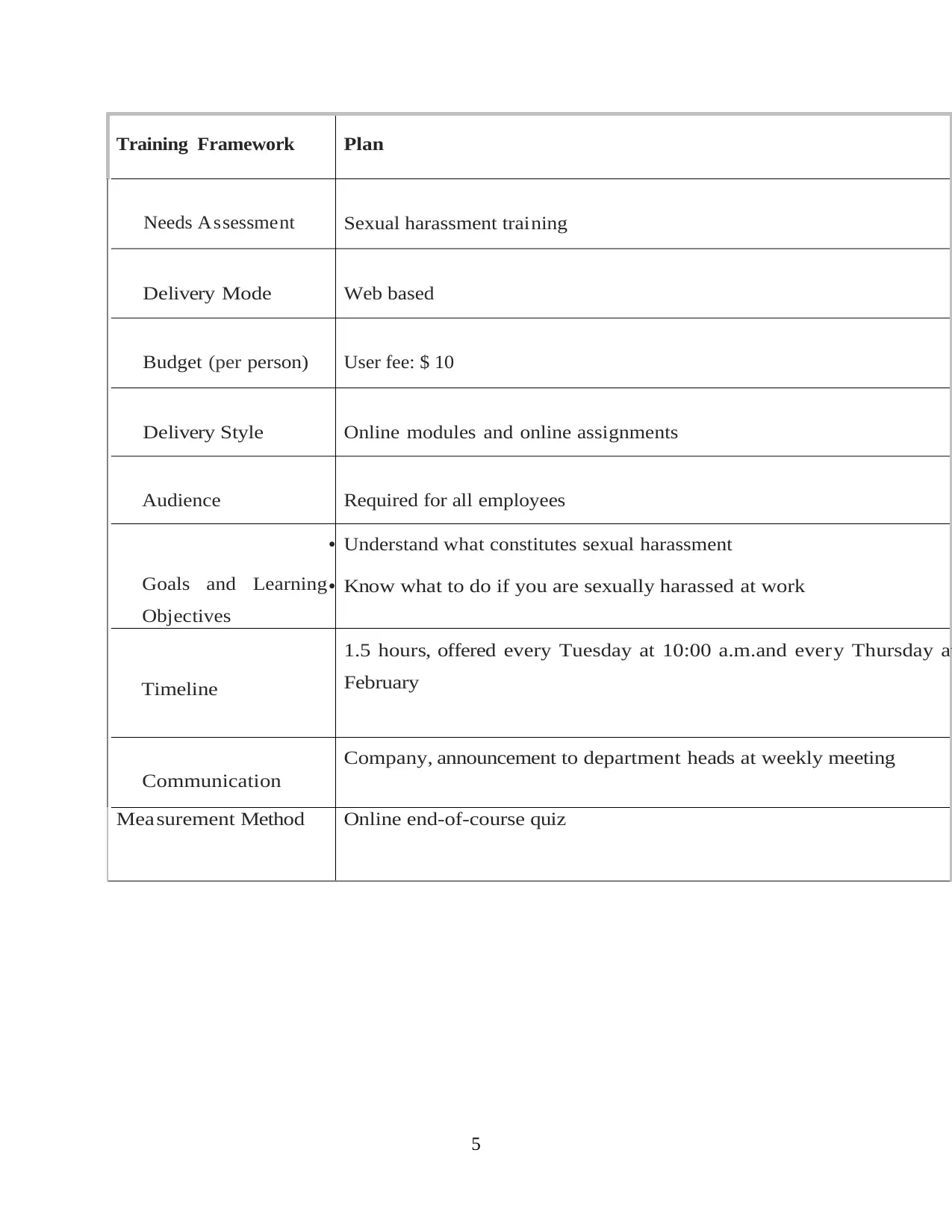
Training Framework Plan
Needs Assessment Sexual harassment training
Delivery Mode Web based
Budget (per person) User fee: $ 10
Delivery Style Online modules and online assignments
Audience Required for all employees
Goals and Learning
Objectives
• Understand what constitutes sexual harassment
• Know what to do if you are sexually harassed at work
Timeline
1.5 hours, offered every Tuesday at 10:00 a.m.and every Thursday at
February
Communication
Company, announcement to department heads at weekly meeting
Measurement Method Online end-of-course quiz
5
Needs Assessment Sexual harassment training
Delivery Mode Web based
Budget (per person) User fee: $ 10
Delivery Style Online modules and online assignments
Audience Required for all employees
Goals and Learning
Objectives
• Understand what constitutes sexual harassment
• Know what to do if you are sexually harassed at work
Timeline
1.5 hours, offered every Tuesday at 10:00 a.m.and every Thursday at
February
Communication
Company, announcement to department heads at weekly meeting
Measurement Method Online end-of-course quiz
5
Secure Best Marks with AI Grader
Need help grading? Try our AI Grader for instant feedback on your assignments.
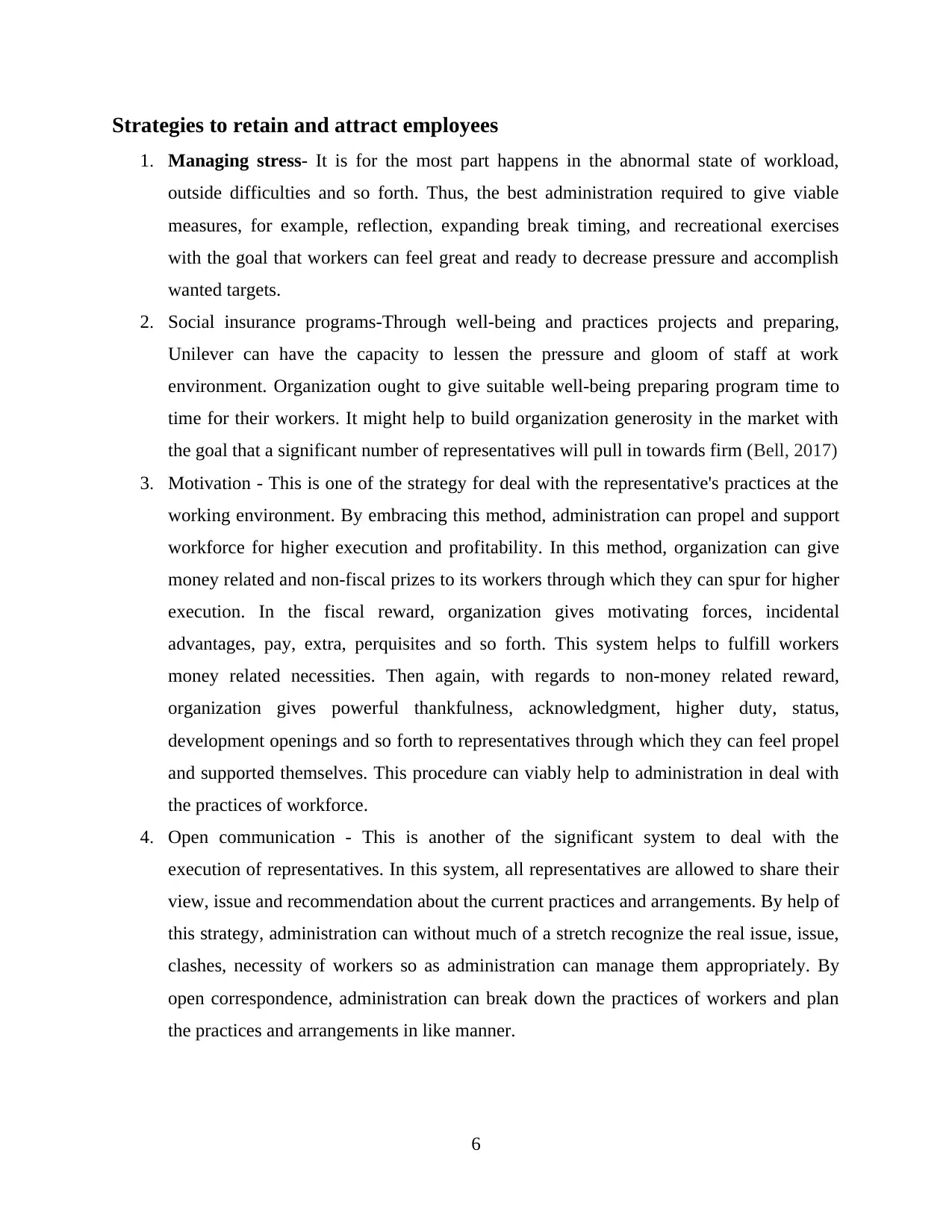
Strategies to retain and attract employees
1. Managing stress- It is for the most part happens in the abnormal state of workload,
outside difficulties and so forth. Thus, the best administration required to give viable
measures, for example, reflection, expanding break timing, and recreational exercises
with the goal that workers can feel great and ready to decrease pressure and accomplish
wanted targets.
2. Social insurance programs-Through well-being and practices projects and preparing,
Unilever can have the capacity to lessen the pressure and gloom of staff at work
environment. Organization ought to give suitable well-being preparing program time to
time for their workers. It might help to build organization generosity in the market with
the goal that a significant number of representatives will pull in towards firm (Bell, 2017)
3. Motivation - This is one of the strategy for deal with the representative's practices at the
working environment. By embracing this method, administration can propel and support
workforce for higher execution and profitability. In this method, organization can give
money related and non-fiscal prizes to its workers through which they can spur for higher
execution. In the fiscal reward, organization gives motivating forces, incidental
advantages, pay, extra, perquisites and so forth. This system helps to fulfill workers
money related necessities. Then again, with regards to non-money related reward,
organization gives powerful thankfulness, acknowledgment, higher duty, status,
development openings and so forth to representatives through which they can feel propel
and supported themselves. This procedure can viably help to administration in deal with
the practices of workforce.
4. Open communication - This is another of the significant system to deal with the
execution of representatives. In this system, all representatives are allowed to share their
view, issue and recommendation about the current practices and arrangements. By help of
this strategy, administration can without much of a stretch recognize the real issue, issue,
clashes, necessity of workers so as administration can manage them appropriately. By
open correspondence, administration can break down the practices of workers and plan
the practices and arrangements in like manner.
6
1. Managing stress- It is for the most part happens in the abnormal state of workload,
outside difficulties and so forth. Thus, the best administration required to give viable
measures, for example, reflection, expanding break timing, and recreational exercises
with the goal that workers can feel great and ready to decrease pressure and accomplish
wanted targets.
2. Social insurance programs-Through well-being and practices projects and preparing,
Unilever can have the capacity to lessen the pressure and gloom of staff at work
environment. Organization ought to give suitable well-being preparing program time to
time for their workers. It might help to build organization generosity in the market with
the goal that a significant number of representatives will pull in towards firm (Bell, 2017)
3. Motivation - This is one of the strategy for deal with the representative's practices at the
working environment. By embracing this method, administration can propel and support
workforce for higher execution and profitability. In this method, organization can give
money related and non-fiscal prizes to its workers through which they can spur for higher
execution. In the fiscal reward, organization gives motivating forces, incidental
advantages, pay, extra, perquisites and so forth. This system helps to fulfill workers
money related necessities. Then again, with regards to non-money related reward,
organization gives powerful thankfulness, acknowledgment, higher duty, status,
development openings and so forth to representatives through which they can feel propel
and supported themselves. This procedure can viably help to administration in deal with
the practices of workforce.
4. Open communication - This is another of the significant system to deal with the
execution of representatives. In this system, all representatives are allowed to share their
view, issue and recommendation about the current practices and arrangements. By help of
this strategy, administration can without much of a stretch recognize the real issue, issue,
clashes, necessity of workers so as administration can manage them appropriately. By
open correspondence, administration can break down the practices of workers and plan
the practices and arrangements in like manner.
6
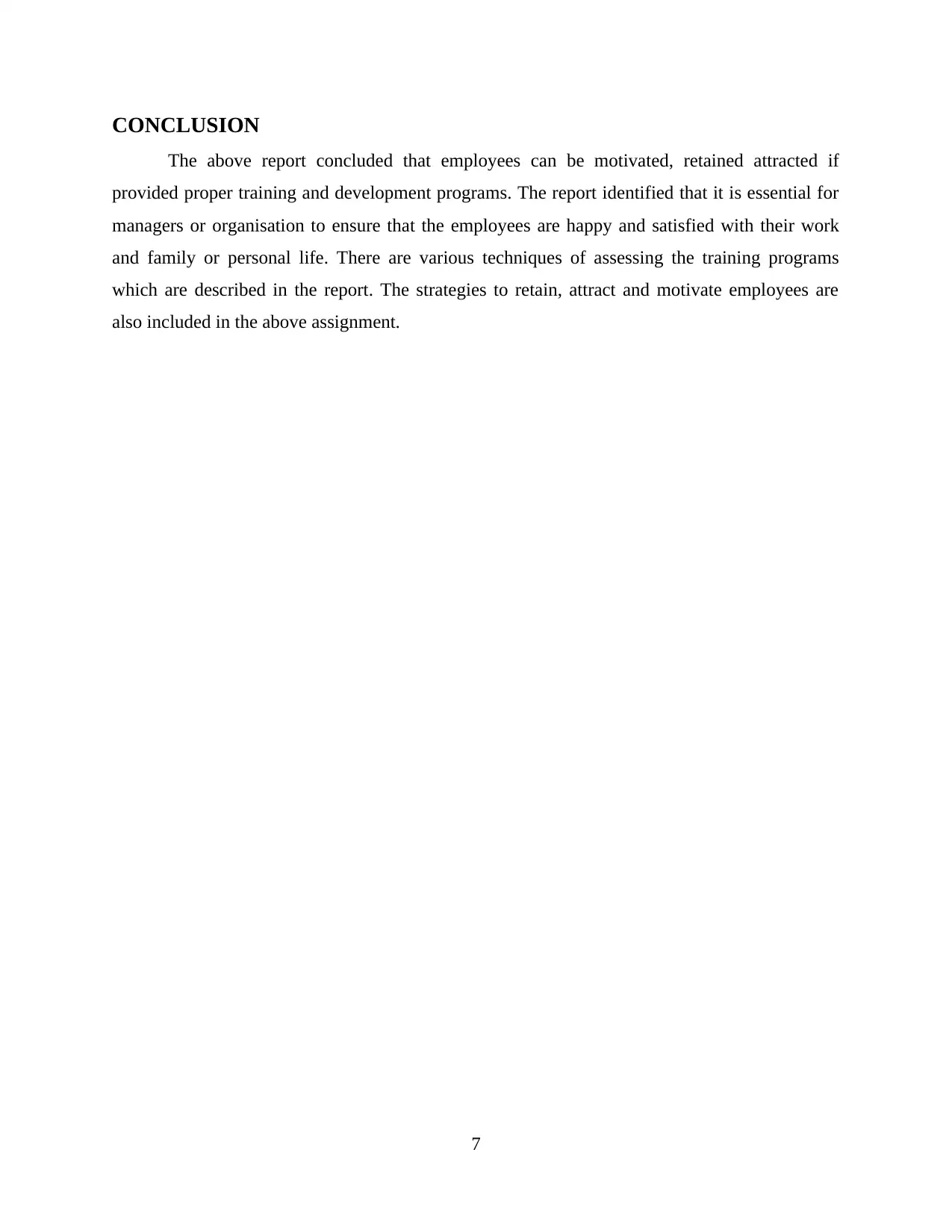
CONCLUSION
The above report concluded that employees can be motivated, retained attracted if
provided proper training and development programs. The report identified that it is essential for
managers or organisation to ensure that the employees are happy and satisfied with their work
and family or personal life. There are various techniques of assessing the training programs
which are described in the report. The strategies to retain, attract and motivate employees are
also included in the above assignment.
7
The above report concluded that employees can be motivated, retained attracted if
provided proper training and development programs. The report identified that it is essential for
managers or organisation to ensure that the employees are happy and satisfied with their work
and family or personal life. There are various techniques of assessing the training programs
which are described in the report. The strategies to retain, attract and motivate employees are
also included in the above assignment.
7
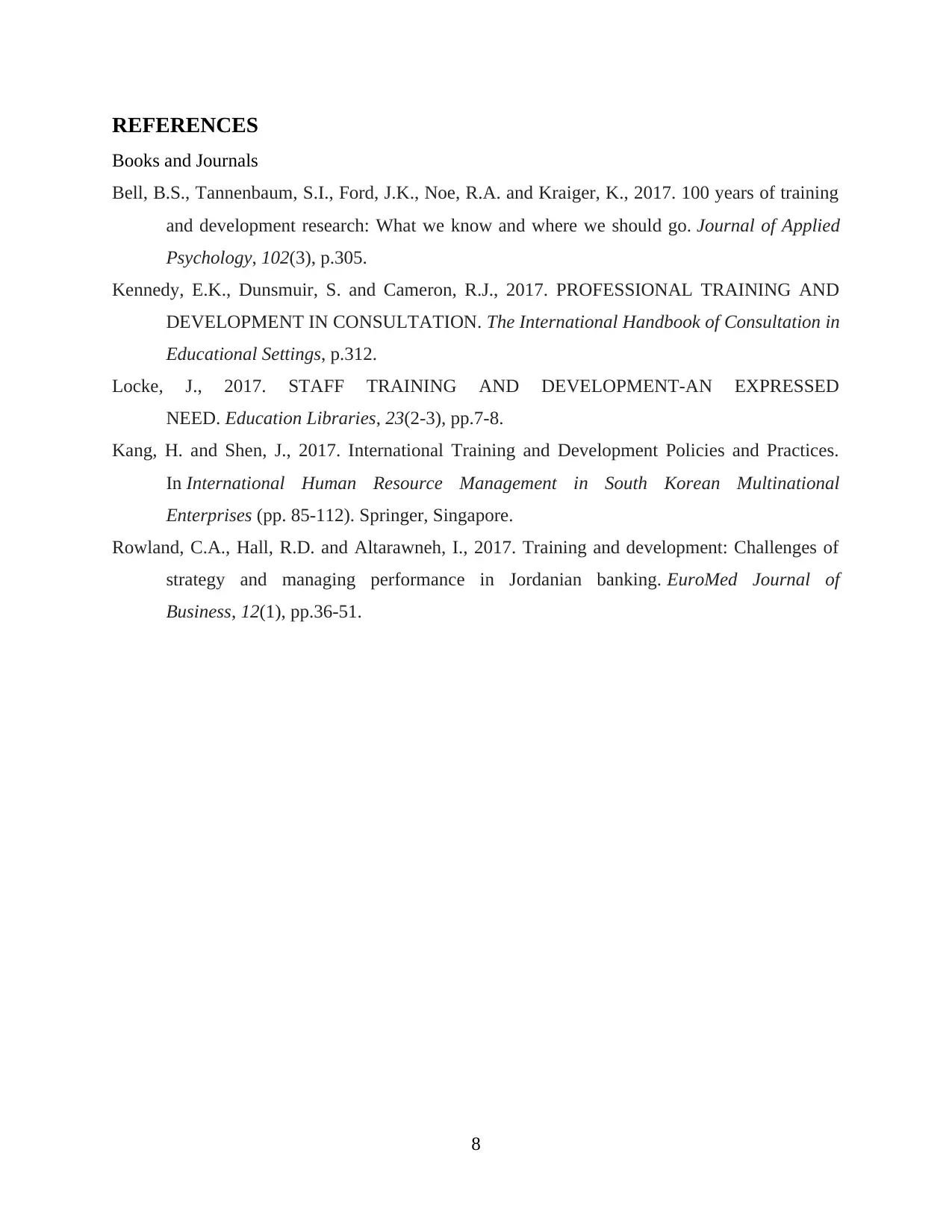
REFERENCES
Books and Journals
Bell, B.S., Tannenbaum, S.I., Ford, J.K., Noe, R.A. and Kraiger, K., 2017. 100 years of training
and development research: What we know and where we should go. Journal of Applied
Psychology, 102(3), p.305.
Kennedy, E.K., Dunsmuir, S. and Cameron, R.J., 2017. PROFESSIONAL TRAINING AND
DEVELOPMENT IN CONSULTATION. The International Handbook of Consultation in
Educational Settings, p.312.
Locke, J., 2017. STAFF TRAINING AND DEVELOPMENT-AN EXPRESSED
NEED. Education Libraries, 23(2-3), pp.7-8.
Kang, H. and Shen, J., 2017. International Training and Development Policies and Practices.
In International Human Resource Management in South Korean Multinational
Enterprises (pp. 85-112). Springer, Singapore.
Rowland, C.A., Hall, R.D. and Altarawneh, I., 2017. Training and development: Challenges of
strategy and managing performance in Jordanian banking. EuroMed Journal of
Business, 12(1), pp.36-51.
8
Books and Journals
Bell, B.S., Tannenbaum, S.I., Ford, J.K., Noe, R.A. and Kraiger, K., 2017. 100 years of training
and development research: What we know and where we should go. Journal of Applied
Psychology, 102(3), p.305.
Kennedy, E.K., Dunsmuir, S. and Cameron, R.J., 2017. PROFESSIONAL TRAINING AND
DEVELOPMENT IN CONSULTATION. The International Handbook of Consultation in
Educational Settings, p.312.
Locke, J., 2017. STAFF TRAINING AND DEVELOPMENT-AN EXPRESSED
NEED. Education Libraries, 23(2-3), pp.7-8.
Kang, H. and Shen, J., 2017. International Training and Development Policies and Practices.
In International Human Resource Management in South Korean Multinational
Enterprises (pp. 85-112). Springer, Singapore.
Rowland, C.A., Hall, R.D. and Altarawneh, I., 2017. Training and development: Challenges of
strategy and managing performance in Jordanian banking. EuroMed Journal of
Business, 12(1), pp.36-51.
8
Paraphrase This Document
Need a fresh take? Get an instant paraphrase of this document with our AI Paraphraser

9
1 out of 11
![[object Object]](/_next/static/media/star-bottom.7253800d.svg)





